We Communicate For Happy Children
 Criminality Against Children from the Gateway of Palestine
Criminality Against Children from the Gateway of Palestine 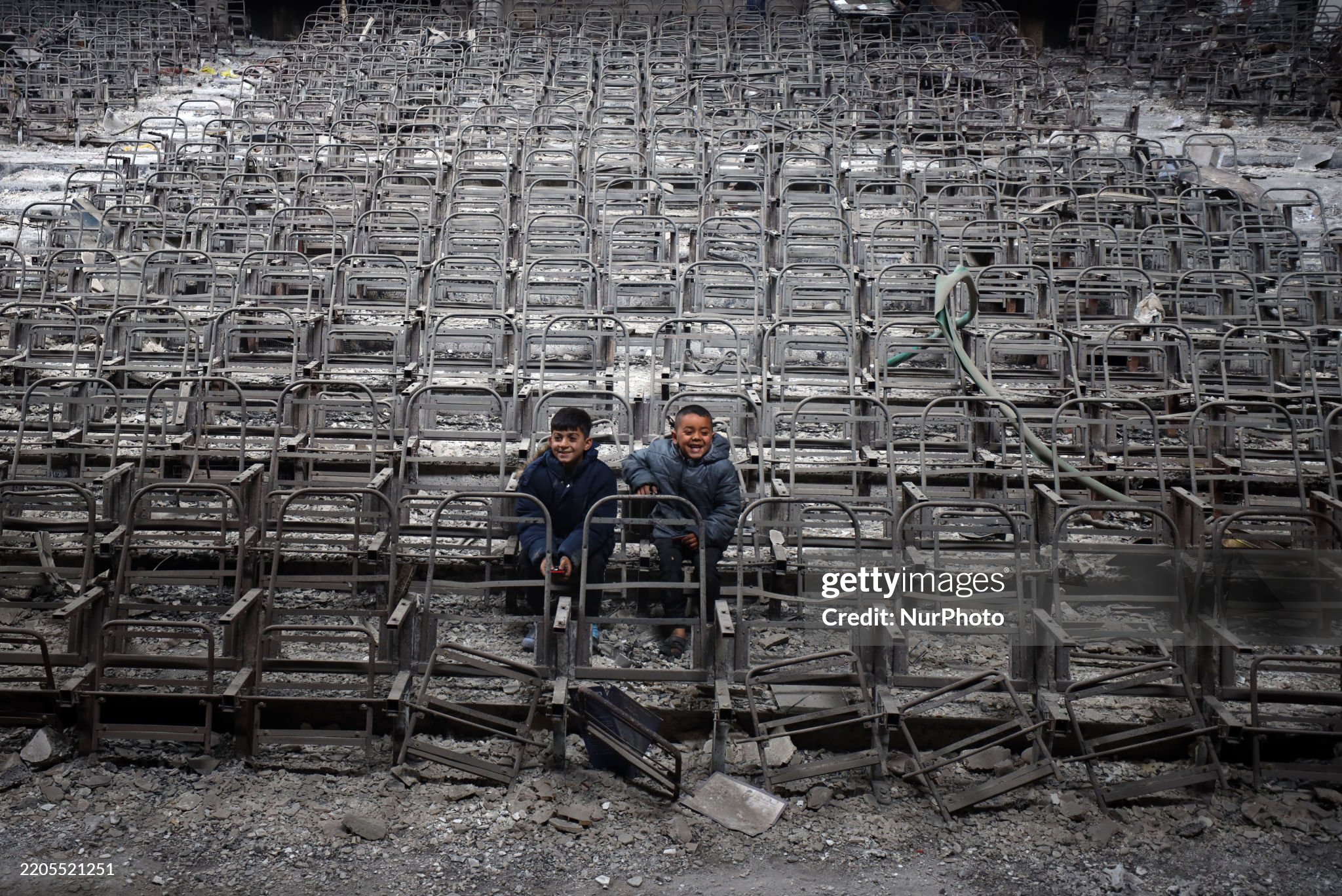
Zeinab Srour
16 April 2025
The year 2024 witnessed an unprecedented increase in the number of wars around the world since the end of the Second World War. Humanitarian crises deepened dramatically, and violations of children’s rights reached a record level. The violations varied between killings, injuries, deprivation of education, displacement, loss of life-saving vaccines, exposure to severe malnutrition, and famine. According to UNICEF, the impact on children reached “devastating and likely record levels”.
While conflict zones varied geographically, Arab countries ranked first in terms of their number and thus their impact at various levels. For example, the Food and Agriculture Organization of the United Nations (FAO) and the World Food Program (WFP) ranked six Arab countries among the top ten most dangerous hunger hotspots in the world. This announcement was preceded at the end of last year by a warning that acute food insecurity would worsen in countries and regions, including Arab countries.
Although the suffering of children is incomparable, the conditions of Palestinian children and their historical injustice top the list. Palestine represents a blatant example of the violation of all children’s rights without exception, especially with the ongoing genocide in the Gaza Strip. With the Israeli occupation violation of the ceasefire agreement on 18/3/2025, the second wave of genocide was more ferocious and aggressive than the first. While the voices of humanitarian and relief organizations, as well as those working in the field of human rights and children, were hoarse in demanding a ceasefire and the entry of aid, the occupation chose to ignore humanitarian laws, international agreements, and the Convention on the Rights of the Child. It persisted in the killing, the starvation, the destruction, and the deliberate bombing of the infrastructure. It has also used humanitarian aid and commercial supplies as a weapon in its ongoing genocide against the Palestinian people for over 18 months. Moreover, instead of increasing the aid flow to more than two million people, including over one million children, to compensate for the severe shortages that preceded the ceasefire, the occupation has increased the blockade piling up food, medicine, fuel, and shelter supplies stuck at the crossings entrances.
As for the occupied West Bank, the occupation and its settlers have intensified their “silent war” against families. Continuing the policy of setting “records”, Israeli attacks have resulted in the largest wave of population displacement witnessed in the West Bank since 1967.
First: “Young communities”
Since the resumption of bombing of Gaza, at least 100 children have been killed and injured daily according to UNICEF. This brings the total to more than 18000, with tens of thousands more injured. The same is true in the West Bank, where injuries among children are increasingly high compared to the total number of injuries.
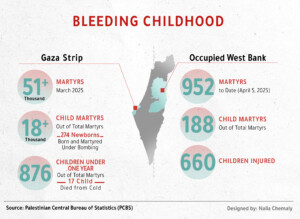
As for the injuries classified as lifelong, they were distributed as follows:
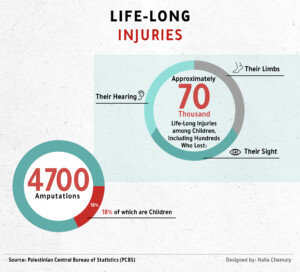
For those who follow the Palestinian affairs, these percentages are not surprising, even if the figures are shocking given the ferocity of the killing. For decades, Palestinian children have accounted for a high proportion of casualties. For instance, the 2008-2009 aggression on Gaza resulted in the deaths of more than 1400 Palestinians, including more than 400 children.
This is due to two main reasons:
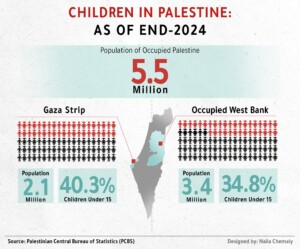
Second: The weapon of starvation and thirst
With the shutting down of the 25 bakeries supported by the World Food Program and the occupation preventing the aid flow, Gaza and its children have entered a more dangerous phase where all previous warnings might, unfortunately, come true. At the beginning of April 2025, heads of seven international organizations including WFP and UNICEF refuted “assertions that there is now enough food to feed all Palestinians in Gaza”, and they described these assertions as “far from the reality on the ground”.
Famine and malnutrition were already threatening the lives of children in Gaza before the resumption of the second genocide wave, and 52 child deaths due to malnutrition have been recorded. Unless aid is allowed in, these numbers are likely to rise. The Integrated Food Security Phase Classification (IPC), known for its accurate assessment, predicted that approximately 60,000 cases of acute malnutrition would be recorded among children (6 to 59 months) by August 2025, along with thousands of cases among pregnant and lactating women. The greatest concerns are the 12,000 cases of severe acute malnutrition among children. This leads to serious health complications, including organ failure or death.
Gaza is also suffering from a water crisis, since the occupation destroyed most water wells, and the Mekorot pipeline that comes from the occupied territories and supplies 70% of the needs has been disabled. Furthermore, the interruption of water supplies and the destruction of infrastructure as summer approaches pose an additional threat to children’s lives and health.
To mention is that the water crisis in Gaza predates the current war by decades. During the years of the occupation of Gaza (1967-2005), Israeli settlements depleted a large portion of its groundwater. Water consumed by these settlements was estimated at approximately 25% of the aquifer capacity of Gaza, exposing the latter to a severe water shortage. Groundwater pollution is equally alarming. Before the war, sewage networks covered only 60% of housing. Approximately 80% of untreated sewage was discharged into the sea, and 20% of it seeped into the aquifer. With the accumulation of factors, primarily Israel policies and repeated wars on Gaza, the water crisis worsened. It reached the point where the United Nations declared in 2012 that Gaza would be uninhabitable by 2020. Water shortages and pollution were considered among the main reasons for this declaration.
Third: The orphanhood catastrophe
The crisis of orphans and separated children in Gaza is multidimensional, compounding the challenges of response and relief. Gaza was already witnessing a rise in the number of orphans due to repeated wars. Meanwhile, the social welfare sector was suffering from a lack of staff and services. Although child-focused organizations and institutions including UNICEF provided care and psychosocial support services, these services fell short of the needs.
In the current war, all services, including social welfare, have been disrupted. While it is common for extended families to care for a child who has lost a parent, these families suffer from a severe shortage of the basic necessities needed to care for the child. On top of that, many children have lost their extended families that have been erased from the civil registry. As a result of the heavy bombardment, repeated displacement, and the high number of missing persons and those still under the rubble, tens of thousands of children have been separated from their families. Families in Gaza have often breathed a sigh of relief when they found their children, even if martyrs.
The conditions of these children are beyond description: severe psychological and social crises, profound psychological disorders, chronic fear and depression, not to mention poor learning and social development. This is the worst orphanhood crisis in modern history, and it requires unprecedented mobilization, plans, and interventions.
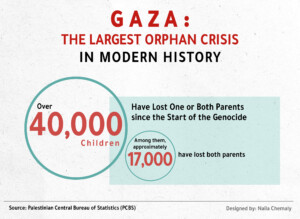
Fourth: forced displacement
The policy of displacing Palestinian families is not new. With the current genocide, it has become a tool and a fundamental pillar that Israel is working to “legalize” under the pretext of “protecting civilians”. With the completion of the second wave of genocide, 70% of Gaza became areas prohibited by the occupation army as “buffer zones” or under evacuation warning according to the United Nations. This covers more than two million people including hundreds of thousands who have been displaced multiple times by extremely difficult means, such as the use of animals or on foot. Tens of thousands remain stranded, either due to direct Israeli targeting of displaced persons on roads designated as safe, the lack of designated safe roads, or the lack of transportation and the prohibitive cost of those that do exist.
Displaced families and children are crowded into areas used as shelters, such as overcrowded schools and hospitals that lack the most basic necessities of life, worsening health conditions. Furthermore, since nothing is safe from the Israeli killing machine, the occupation has targeted displacement camps, schools, hospitals, in addition to families and children gathered to receive humanitarian aid.
As for the West Bank, it is witnessing the largest forced displacement since 1967. This includes thousands of families and children (3227 families in Jenin camp alone). These people are experiencing multiple crises: killing and arbitrary detention, restrictions on movement with more than 800 Israeli military checkpoints and barriers where children are subjected to searches and intimidation, the demolition of homes and infrastructure, and the seizure of Palestinian property by settlers under Israeli military and legal cover. Last year, the United Nations had designated the year 2023 as a record year for the displacement of children in the West Bank. Since then, the conditions of children have exponentially worsened.
Fifth: Systematic destruction of medical and health capacities
What Israel has done during the current genocide through targeting healthcare providers, doctors, and paramedics represents a systematic destruction not only of the health sector, but of medical and health assets as a whole.
The 1500 martyrs of medical personnel in nearly two years, along with tens of thousands of wounded, especially experienced doctors, means, at the very least, years of training and learning to compensate for what has been lost. This comes amidst the disruption of the education system, the targeting of universities, and the pressure to expel brains from Gaza.
What does this mean for children, their parents, and their caregivers?
It means prolonging the necessary physical, health, and psychological recovery period and thus increasing the risk of preventable child deaths and injuries. It also means additional pressure on the response mechanisms required for the post-war phase. This, in itself, is an extension of the genocide after its end.
Sixth: War on education
The education system in occupied Palestine is suffering from a profound crisis. Decades of war, occupation, displacement, and systemic inequality have severely weakened children’s access to education, both in Gaza and the West Bank. This systematic policy has created a cross-generational education crisis that has left countless children without the basic support and structure needed to provide education.
During the current war, Israel has intensified its systematic policies against children and educational staff. Even nurseries and kindergartens were not spared. To address this, several community initiatives were established last year to address the educational needs of children in Gaza and mitigate the impact of the education disruption. Despite these achievements, only 25% of school-age children were able to access any form of education there during 2024.
As for the West Bank, the escalation of the “silent war” there has hindered education access for more than 800,000 students. This follows decades of abusive Israeli policies that have affected the educational system, including inspections at military checkpoints, restrictions on access, arrests of children and educational staff, demolition of schools, confiscation of funds and teachers’ salaries, and attempts to impose the Israeli curriculum by force.

